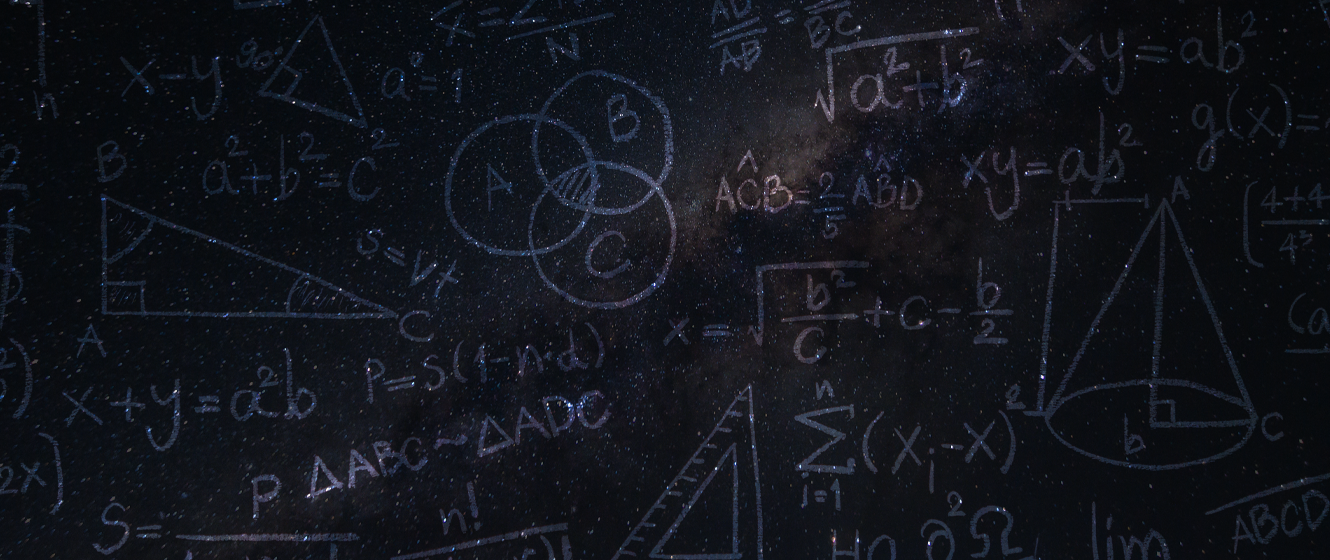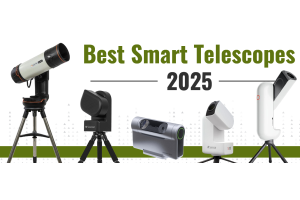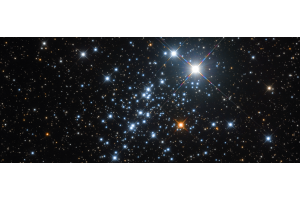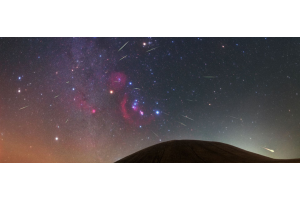
Let’s be honest: few of us like math, but there are a handful of formulae that can be useful to the amateur astronomer and can help you make the most of your equipment. While most of these formulae will be primarily applicable to telescopes, there are a few that can also be applied to binoculars.
Unfortunately, some might require a calculator, so once you’ve done the math, it’s worth keeping a note of your equipment capabilities in a small notebook you can carry with you. That way, you can easily refer to it when you’re at a dark sky location - and you won’t be bothering anyone else by using your cell phone!
Lastly, if you’re not comfortable with the math, some specifications may be found in your equipment’s user manual, online, or even on the equipment itself, which might save you a few headaches.
More specifically, these include:
- The angular field of view of binoculars
- The exit pupil diameter of binoculars
- The resolving power of a telescope or binoculars
- The limiting magnitude of a telescope or binoculars
- The focal ratio of a telescope
- The maximum useful magnification of a telescope
That said, if you’ve lost the manual or the data isn’t listed, these formulae should give you all the information you need.
Formulae For Binoculars
Angular Field of View
For anyone using binoculars during the day, the angular field of view may be of secondary concern, but if you’re into astronomy, it’s definitely something you’ll want to know. For example, if you know the angular distance between, say, the Moon and a planet or bright star, knowing the angular field of view of your binoculars will tell you if the pair can be seen together. (If you have the SkySafari app, you can then customize a Scope Display circle to simulate the view.)
Incidentally, it’s worth keeping in mind the following tips:
- The Moon is, on average, about half a degree (30 arcseconds) in diameter
- The Pleiades are about 2 degrees in diameter
- The Hyades are about 4.5 degrees in diameter
- Most 10x50 binoculars have a field of view of 6.5 degrees, so any star or planet within that distance from the center of the Moon should be visible within the same field of view. For reference, the head of Draco, the Dragon, should just about fit.
The angular field of view will vary, depending on the magnification and the aperture, but you can calculate it with the following formula:
Angular Field of View = Linear Field of View (feet) @ 1000 yards ÷ 52.5
or Angular Field of View = Linear Field of View (meters) @ 1000 meters ÷ 17.5
The linear field of view is the width of an object that would fill the field of view from either 1,000 yards or 1,000 meters. Traditionally, manufacturers would specify this in terms of imperial feet, but more recently, you’ll also find it listed as metric meters.
The linear field of view can typically be found at the top one of the barrels (often the right barrel), near the eyepiece. Binoculars that are specifically designed for astronomy may also have the angular field of view printed there.
For example, the Cometron 7x50 binoculars from Celestron have a linear field of view of 344 feet at 1,000 yards, or 105 meters at 1,000 meters. It, therefore, has an angular field of view of 6.6 degrees, if you calculate it based on feet/yards, or exactly 6 degrees if you go by meters.
Which is more accurate? The general consensus is that feet/yards give a more accurate result, but if you want to err on the side of caution, it’s best to use the lower number.
Formulae For Telescope & Binoculars
Exit Pupil Diameter
Before we learn how to calculate this, it’s worth remembering what the exit pupil actually is. Essentially, the exit pupil can be thought of as the width of the light exiting the eyepiece. The larger the exit pupil, the more light can be delivered to your eye, with a larger exit pupil being better suited to dark conditions. That said, the pupil of the human eye has a diameter of 7mm, and an eyepiece exit pupil greater than 7mm will only result in wasted light.
To calculate the exit pupil of your binoculars or eyepiece: Exit Pupil Diameter = Aperture ÷ Magnification
For binoculars, this is pretty straightforward. For example, 10x50 binoculars have an exit pupil of 5mm (50 / 10), while 20x50 binoculars have an exit pupil of 2.5mm. In this case, while the 20x50 binoculars will double the magnification, the image will be dimmer, and you won’t see any more detail because the aperture (50mm) is the same.
(This is why 10x50 binoculars are a good choice for astronomy. They have an excellent combination of magnification, aperture, and image brightness. 7x35 binoculars, while having the same exit pupil - and therefore the same image brightness - have a smaller magnification and aperture. 20x80 binoculars have a larger magnification and aperture, but a smaller exit pupil, and therefore produce a fainter image.)
For a telescope, things are a little more complicated as you’ll need to know the magnification of the eyepiece you’re using (see below). As a result, the exit pupil will vary, depending on the eyepiece.
Let’s say you’re using an eyepiece that gives a magnification of 50x on a 150mm aperture telescope. This results in an exit pupil of 3mm. A magnification of 30x results in an exit pupil of 5mm, while a magnification of 75x will give you an exit pupil of 2mm. (Compare that to a 250mm aperture scope, which will give exit pupils of 5mm, 8mm, and 3mm, respectively, resulting in a brighter image.)
Limiting Magnitude
What’s the faintest object you can see with your equipment? Could it detect Pluto? This formula will give you the answer, but unfortunately, you’ll need access to a scientific calculator or equivalent app to get it. There’s no easy “take this number and divide by that number” here.
If you’re still feeling up to the task, the formula is: Limiting Magnitude = 7.7 + (5 x Log (Equipment Aperture))
The equipment aperture should be in centimeters; if it’s measured in millimeters - as is often the case - you’ll need to first divide that number by ten.
For example, the Apertura AD8 Dobsonian has an aperture of 203.2mm, which is 20.32cm.
- Log 20.32 is 1.3 (rounded to one decimal place)
- 5 x 1.3 is 6.5
- 7.7 + 6.5 = 14.2
Its limiting magnitude is, therefore, 14.2, but the following points should be kept in mind:
- This is the faintest stellar magnitude - ie, the magnitude of an object that appears as a star-like point, such as a star, asteroid, or dwarf planet. It won’t tell you the magnitude of the faintest deep sky object you can detect, since the light from those objects is scattered over an area of sky.
- Like resolving power, maximum magnification, and minimum magnification (see below), this is a theoretical number, and the results will be greatly influenced by the quality of your equipment, the observing conditions, and, potentially, your own eyesight.
Not feeling up to the task? Here’s a table that might be useful:
| Aperture (mm) | Limiting Magnitude | Aperture (mm) | Limiting Magnitude | |
|---|---|---|---|---|
| 50 | 11.2 | 250 | 14.7 | |
| 75 | 12.1 | 300 | 15.1 | |
| 100 | 12.7 | 350 | 15.4 | |
| 125 | 13.2 | 400 | 15.7 | |
| 150 | 13.6 | 450 | 16.0 | |
| 200 | 14.2 | 500 | 16.2 |
Formulae For Telescopes
Magnification
If some of these equations seem a little complicated, here’s a relatively simple one that’s a must-know for amateur astronomers everywhere. The same eyepiece will produce a different magnification when used with different telescopes, and it’s important to know which eyepiece to use to get the magnification you need.
Fortunately, to calculate the magnification of the eyepiece, you only need the following formula: Magnification = Telescope Focal Length (mm) ÷ Eyepiece Focal Length (mm)
If you don’t already know your telescope’s focal length, you can typically find it in one of three places:
- On the side of the optical tube, near the eyepiece holder
- In the instruction manual, or
- On the manufacturer’s website
The eyepiece focal length is printed either at the top or on the side of the eyepiece barrel.
Imagine you have an eyepiece with a focal length of 20mm. In a telescope with a focal length of 600mm, this will produce a magnification of 30x, but if you were to use the same eyepiece in a telescope with a focal length of 1000mm, it will produce a magnification of 50x.
The higher the focal length of the eyepiece, the lower the magnification. Conversely, telescopes with longer focal lengths will produce higher magnifications. (That, plus their great light-gathering capabilities, is what makes larger aperture telescopes best suited to observing small, faint targets, such as galaxies and planetary nebulae.)
Here’s a rough guide to the magnifications best suited to various targets. This information is also useful when determining your telescope’s theoretical maximum magnification (see below).
| Low Magnification (50x or lower) | Comets, wider multiple stars, larger open star clusters, and larger nebulae |
|---|---|
| Medium Magnification (50x to 100x) | Multiple stars, open star clusters, larger globular clusters, and nebulae |
| Medium-High Magnification (100x to 150x) | The planets, multiple stars, globular star clusters, planetary nebulae, and brighter galaxies |
| High Magnification (150x or higher) | The planets, globular star clusters, planetary nebulae, and galaxies |
Focal Ratio
The focal ratio, or f ratio, represents a telescope's "speed.” The lower the ratio, the “faster” the telescope. When it comes to visual observing, this isn’t a particularly important consideration, but it can play a large role in astrophotography.
A faster telescope provides a lower magnification (hence, a wider field of view) but allows light to be gathered more quickly. These factors make a faster scope a better choice for deep sky objects as it allows for a wider field of view and shorter exposure times.
Conversely, a slower telescope provides higher magnification and a narrower field of view. When it comes to imaging the Moon and planets, a slower telescope is more beneficial, as the objects are comparatively bright (and therefore don’t require the same exposure times as nebulae and galaxies), and the higher magnification produces images with greater detail.
The formula to calculate the f ratio is pretty straightforward: Focal Ratio = Telescope Focal Length ÷ Telescope Aperture
For example, the Celestron NexStar 8SE has a focal length of 2032mm and an aperture of 203.2mm, giving an exact f ratio of f/10. This makes it an excellent choice for both lunar and planetary imaging.
Compare that to the Apertura 8" f/4 Imaging Newtonian OTA, which (as its name implies) has a focal ratio of f/4 and is, therefore, a better choice for imaging deep sky objects. Like the NexStar 8SE, it has an aperture of 203.2mm, but a lower focal length of 800mm, resulting in an f/4 ratio. (More precisely, its ratio is f/3.9, but the number is always rounded up or down.)
True Field of View
We already know how to calculate a binocular’s angular field of view (see above), but what about the view through a telescope?
This will depend on the eyepiece you’re using and is calculated with the following formula: True Field of View = Eyepiece Apparent Field of View ÷ Eyepiece Magnification
The eyepiece magnification will vary depending on the telescope you’re using it with, but can easily be calculated by dividing the telescope's focal length by the focal length of the eyepiece itself (see above).
However, you’ll need to know the apparent (or actual) field of view of the eyepiece, which might not be so easy to ascertain. If you’re using the eyepieces that came with the telescope, the chances are they’ll be pretty generic, and the manufacturer won’t state their specifications anywhere. However, if you’re buying an eyepiece (especially a wide field eyepiece), then it should be stated online or on the barrel of the eyepiece itself.
For example, let’s say you’re using an Apertura 15mm Super Wide Angle Eyepiece with the Apertura AD8 Dobsonian reflector. The telescope has a focal length of 1200mm, which gives the eyepiece a magnification of 80x (1200 / 15 = 80).
The eyepiece has an apparent field of view of 70 degrees; to calculate the true field of view, we divide this by the magnification (80x) to get 0.875, or 0.9 degrees. In other words, you’ll see nearly a full degree of sky when this eyepiece and telescope are used together, or nearly three times the width of the full Moon.
Use this combination to observe a mid-sized star cluster, such as one of the three Messiers in Auriga, and the view could be stunning!
Resolving Power
If you’re interested in double and multiple stars, you’ll want to know that your telescope is capable of showing the components. That’s where resolving power comes in. The angular separation between the components of a multiple star system is measured in arcseconds, and your telescope must be capable of resolving the gap between the stars.
There are several ways to calculate the resolving power of your equipment.
Firstly, there’s the Dawes method: Resolving Power = 116 ÷ Telescope Aperture (mm)
Secondly, there’s the Rayleigh method: Resolving Power = 138 ÷ Telescope Aperture (mm)
As an example, a telescope with an aperture of 150mm will have a resolving power of 1.3 arcseconds according to the Dawes method, while the Rayleigh method will give the same telescope a resolving power of 0.9 arcseconds.
Both provide similar results, but there’s no general consensus on which is better. An alternative is to find a middle-ground value, which could be: Resolving Power = 125 ÷ Telescope Aperture (mm)
This also has the benefit of being slightly easier to calculate in your head, as apertures are often multiples of 50, making it easier to compare them to 125, rather than 116 or 138. (It should be noted that this is a theoretical number, and much will depend upon the quality of the equipment optics, the seeing conditions at the time of observation, and, potentially, the quality of your eyesight.
It should also be noted that this formula doesn’t work with binoculars. For example, if we take the middle-ground value, then 10x50 binoculars would have a resolving power of 2.5 arcseconds. However, the star Nu Draconis has a separation of 1.0 arcseconds, but can be easily split in regular 10x50s.)
Maximum Magnification
Another theoretical calculation, knowing the maximum magnification of your telescope, can help you understand both its possibilities and its limitations.
There are two easy ways to get a rough idea of your scope’s maximum magnification: Maximum Magnification = Telescope Aperture (inches) x 60 or Maximum Magnification = Telescope Aperture (mm) x 2
You’ll find these calculations are very approximate and will produce significantly different results. For example, the Apertura AD8 Dobsonian reflector mentioned above has an aperture of 8 inches, or (more precisely) 203.2mm. This gives a theoretical maximum magnification of 480x (based on aperture measured in inches) or 406x (based on aperture measured in mm.)
Therefore, you might want to take the lower value of 406x or, to play it safe, 400x. Lastly, again, in practice, a lot will depend on the quality of your equipment, your local conditions, and your own eyesight.
Minimum Magnification
Finally, we come to a formula you probably won’t find yourself using often but might still be worth knowing for future reference: the minimum magnification of your scope. Like the maximum magnification, this is a theoretical number dependent upon the quality of your equipment and your personal circumstances.
Magnification lower than this minimum could result in an image that can’t be properly focused or is simply poor quality.
The formula is a simple one: Minimum Magnification = Telescope Aperture (inches) 3.6 or Minimum Magnification = Telescope Aperture (mm) ÷ 7
To use the Apertura AD8 Dobsonian reflector again as an example, the minimum magnification is 29x (both methods give the same result).
Another way of looking at this is to consider the longest focal length eyepiece you can use with your telescope.
This can be calculated with the following formula:Longest Eyepiece Focal Length =7 Telescope Focal Ratio
The Apertura AD8 has a focal ratio of f/5.9, which means the longest usable focal length eyepiece would be 41mm. Given the telescope’s focal length of 1200mm, this would produce a magnification of 29x:
- 5.9 x 7 = 41.3
- 1200 / 41.3 = 29.1
(Realistically, 40mm is probably the longest focal length eyepiece you’re likely to find anyway.)
Regardless of whether you’re an expert or a beginner, these formulae can be a useful starting point for understanding the capabilities of your equipment. You might not need them all, and you might not need them all the time, but having them close at hand can certainly be helpful!

Learn More
Interested in diving deeper into the world of astronomy and astrophotography? Not sure where to begin? Check out our AstronomyHub!










